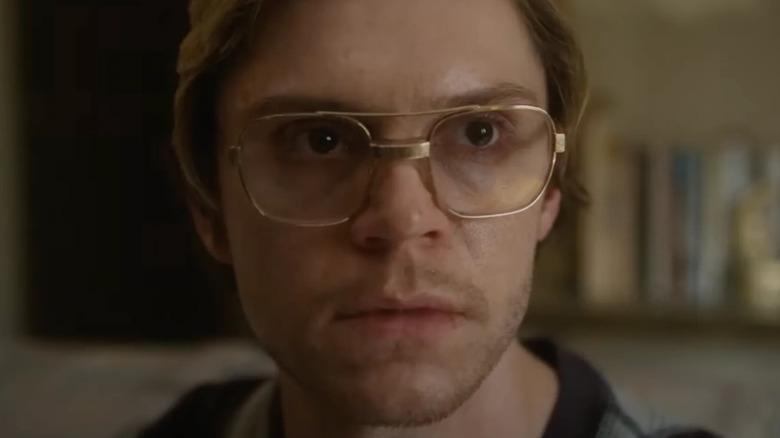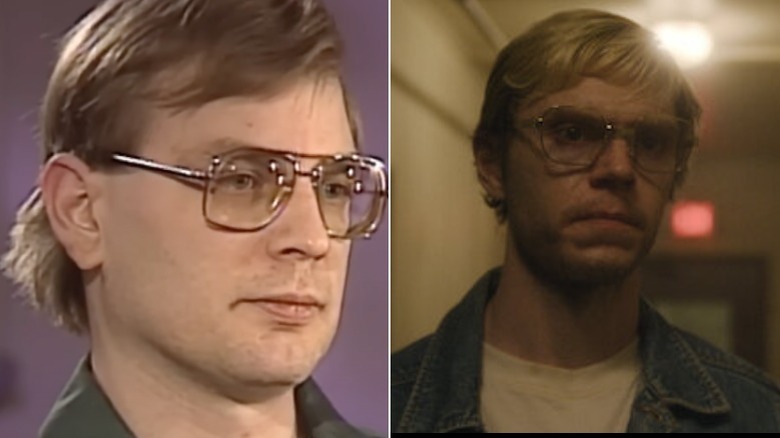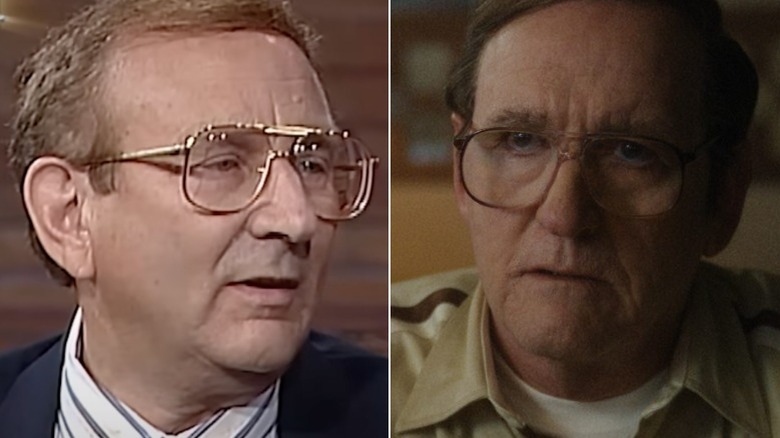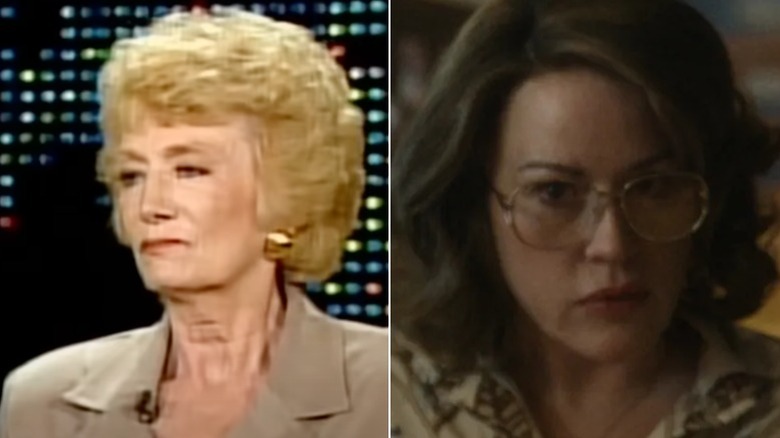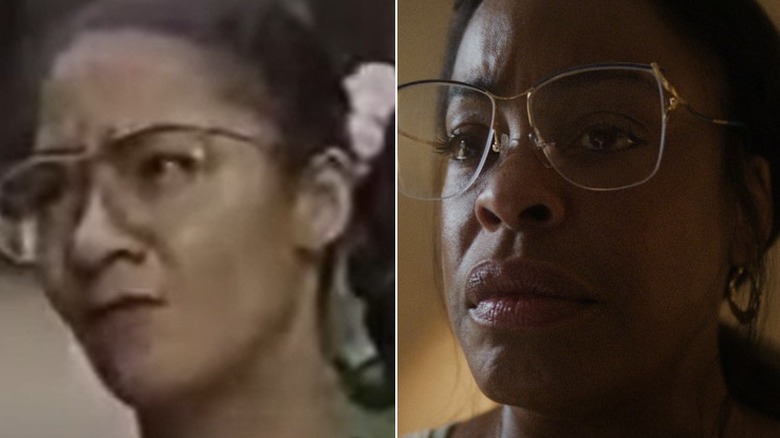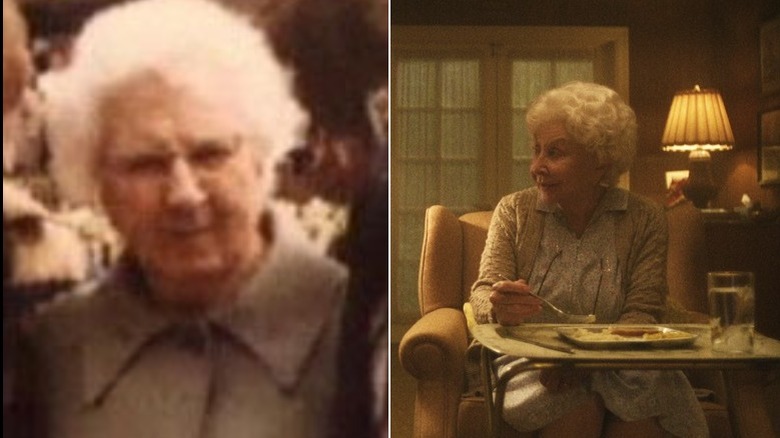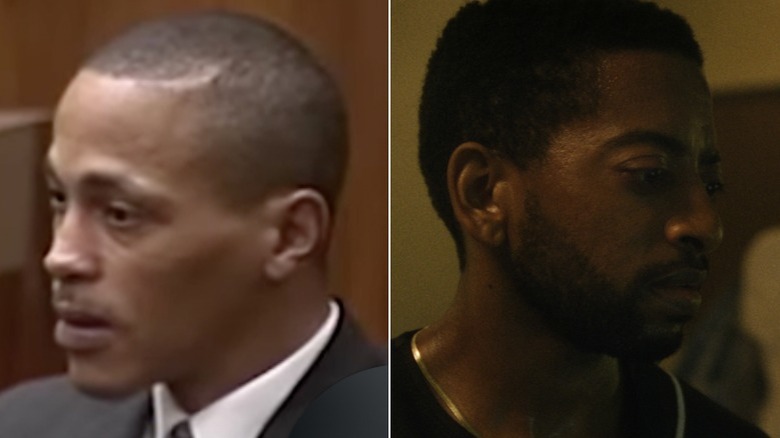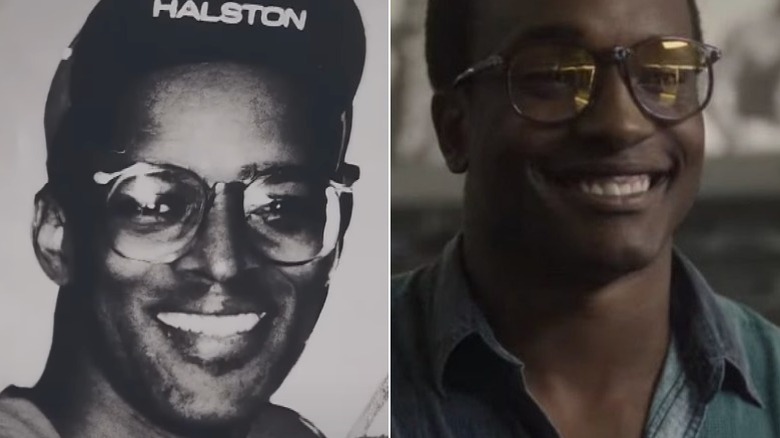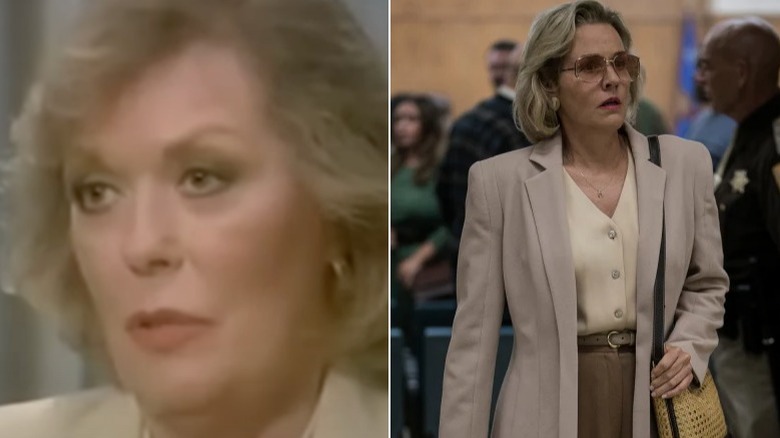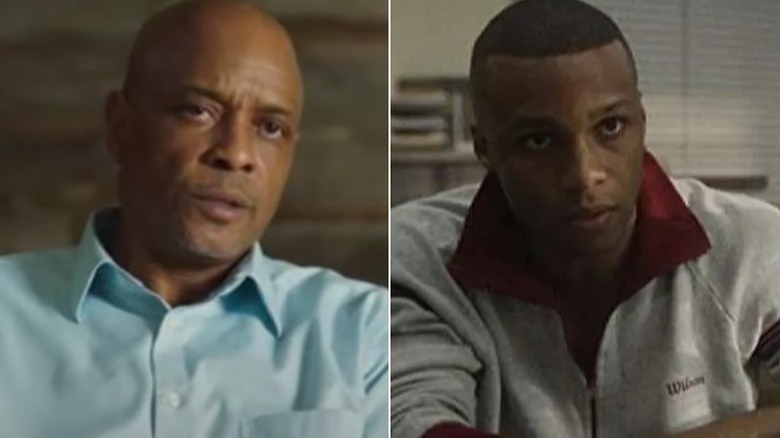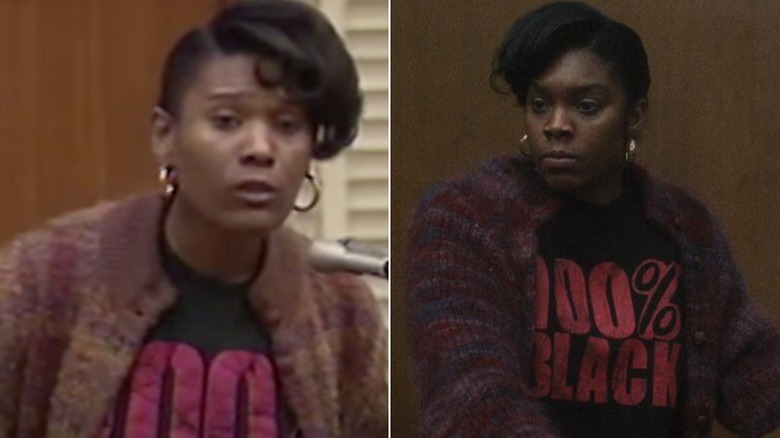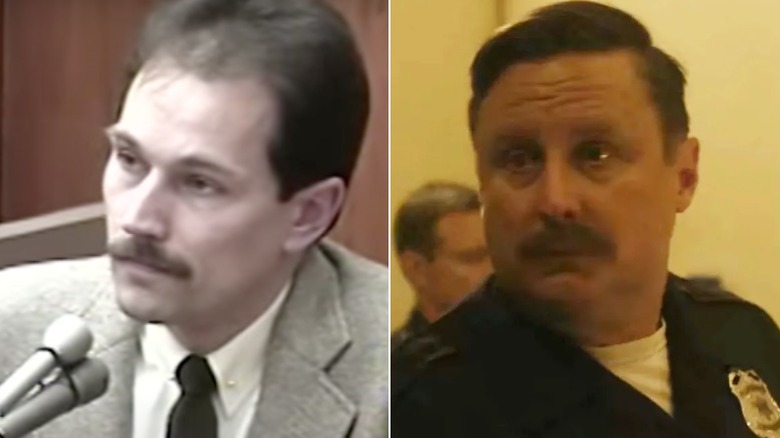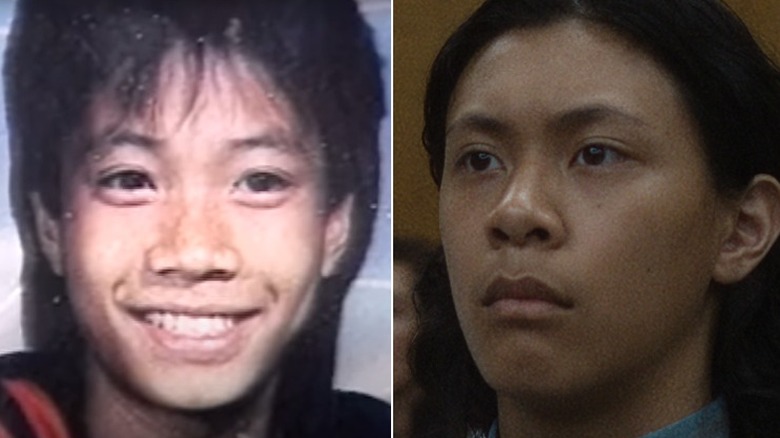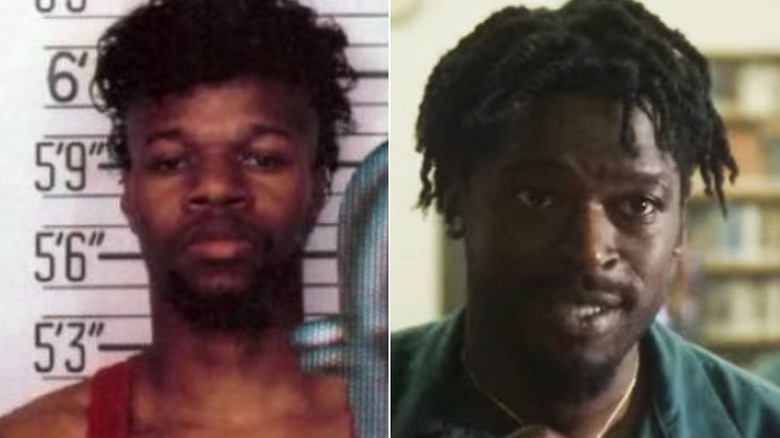What The Cast Of Monster: The Jeffrey Dahmer Story Should Really Look Like
In late September, Ryan Murphy's new horror series "Dahmer – Monster: The Jeffrey Dahmer Story" took over Netflix, breaking the streaming service's record as the most-watched series debut ever, raking in over 196 million watch hours from subscribers in its first week. Propelled by Evan Peters as Dahmer, who went all in on his performance of the ruthless serial killer, "Monster" is one of the most pragmatic true crime series that Netflix has ever made.
The story of "Monster" is meant to be told from the perspectives of Dahmer's victims, rather than the killer himself. There isn't much of a retrospect in the show, as many of the episodes refrain from flashbacks and set their focus on what's happening around the crimes of the present. In the weeks since the show's release, "Monster" has been met with a lot of backlash about set conditions, capitalizing on tragedy, and whether or not the families of Dahmer's victims were contacted about being portrayed in the series.
The cast of "Monster" is expansive, with many notable Hollywood stars taking turns as people who were directly in Dahmer's orbit, either as family, victims, or bystanders attempting to bring his crimes to light. In any case of tasking actors with portraying real-life people, not all of the likenesses are perfect. Here is our breakdown of how each integral character from "Monster: The Jeffrey Dahmer Story" should have really looked.
Jeffrey Dahmer
The titular focus of "Monster" is Jeffrey Dahmer himself, played by Evan Peters. It's no surprise that Peters holds the lead role, as he appears all across Ryan Murphy's resume, including in "Pose" and in multiple "American Horror Story" roles. One of the biggest strengths of "Monster" is how eerily similar each actor is made to look like their character, and Peters' likeness is the pinnacle. From sporting a dirty blonde side part to always wearing thick aviator glasses, Peters' portrayal is perfect, especially the mannerisms the mirror the real-life Dahmer exactly.
Peters' work in horror is nothing short of stellar. He plays his roles with such an intensity that we might occasionally forget that he's playing a character outside of himself. That type of dedication was essential for "Monster," as the show parallels the reality of Dahmer and his crimes to near perfection.
In an interview on Netflix's YouTube page, Peters explained how he watched footage of Dahmer, read biographies about him, and was given access to Dahmer's confession and police report in order to get acquainted with the serial killer's history. "It was so jaw dropping that it all really happened that it felt important to be respectful to the victims, to the victims' families, to try to tell the story as authentically as we could," Peters said. "You need to have certain plot points, because he did do these things, but you don't need to embellish them."
Lionel Dahmer
"Monster" devotes a lot of time on Dahmer's victims, and that includes his father Lionel, who was the only person to show up in support of Dahmer after his capture. Though Lionel did not suffer the violence of his son's murders, "Monster" details how the trial and Dahmer's image affected him in the years after. He writes a book about being the father of one of America's most notorious serial killers, which fails commercially, and later speaks publicly every so often about his experiences raising Dahmer, usually alongside his wife Shari.
At least aesthetically, Richard Jenkins looks identical to the real Lionel. While Peters was able to step into the dialect and accent of Dahmer, Jenkins approaches the character of Lionel from a dramatic, emotional standpoint. Opting to not rely on any accent other than his own, Jenkins, in similar thick-rimmed glasses and an assortment of sweaters and plaid button-down shirts, delivers a powerful performance of a man tasked with believing that his monstrous son still has some goodness deep within him.
Shari Dahmer
Lionel Dahmer's second wife, Shari, is much more present in "Monster" than Jeffrey's mother, Joyce. Played by Molly Ringwald, Shari is the balancing force to Lionel's wary remorsefulness. We don't get much screen time with Shari alone — she is always in tandem with Lionel as he attempts to navigate fatherhood, or the fallout after Dahmer's trial. However, "Monster" portrays her as the woman who stepped up to help Lionel be a parent to Dahmer in the wake of Joyce abandoning him at age 18.
In the years after the trial, Shari and Lionel did interviews together to speak on the history of their son, including an exclusive guest spot on "Larry King Live" in 2004. Ringwald is almost unrecognizable as Shari. She sports big, thin-rimmed glasses and a feathered hairdo. Though there are very few photographs of Shari from the time period of Dahmer's crimes and trial, she is always sporting a much shorter hairstyle. Ringwald more closely resembles a 2020s idea of what a middle-aged woman from 1990 looked like, rather than Dahmer's actual stepmom.
Glenda Cleveland
The heart and soul of "Monster" belongs to its central hero, Glenda Cleveland. Played marvelously by Niecy Nash, Cleveland is the driving force in the effort to catch Dahmer. In "Monster," she lives in the next apartment down the hall from Dahmer, and the two characters share ventilation. The horrid smells coming from Dahmer's living room emit through Cleveland's vent. In reality, according to her 2011 obituary, Cleveland lived in a nearby apartment building.
The defining piece of Cleveland's wardrobe — as is curiously the case for other characters on the show — is her oversized glasses. Nash doesn't look much like her real-life counterpart, at least not in the way that Peters looks like Dahmer, but the focus is not on the appearance. Instead, "Monster" wants to prioritize how the Milwaukee police's unserious attitude towards racial inequity led them to neglect the neighborhood where Dahmer committed most of his crimes. Cleveland is positioned as the catalyst in a series of phone calls and complaints made against Dahmer for months.
The infamous conversation that Cleveland has with a Milwaukee police officer after discovering a bloody and disoriented Konerak Sinthasomphone outside Dahmer's apartment actually happened, though Murphy embellished how close she was to the serial killer throughout the months when his crimes were occurring.
Catherine Dahmer
For a period of time in the 1980s, Dahmer lived with his paternal grandmother Catherine in West Allis, Wisconsin, after moving away from his father in Ohio. The cause for the move was Dahmer being honorably discharged from the army and later arrested for drunk and disorderly conduct in public.
In the show, Catherine is shown to be unaware of the murders happening in her basement, even after she catches wind of odors emitting from beyond the door. It has never been confirmed whether Catherine knew anything at all, nor do we know if the scene where her son Lionel comes over to examine the foul smells coming from the basement happened in real life.
Emmy-winning actress Michael Learned plays Catherine in "Monster," and the resemblance, per the few photographs that exist of Dahmer's grandmother, is uncanny. Learned sports a full head of short, curly, white hair and is often wearing a cardigan or robe atop a patterned blouse, much like Catherine did in real life. In the show, Catherine is shown to be suffering from dementia around the time of Dahmer's trial, and she passed away in 1992.
Tracy Edwards
One of the first characters we meet in "Monster" is Tracy Edwards, the last of Dahmer's victims. Played by Shaun J. Brown, Edwards is a hero within the Dahmer case, though his life since has been filled with trauma and inequity. In real life and in the show, Edwards escapes Dahmer's violence and alerts the police. Because of Edwards' escape, Dahmer is eventually captured, and his apartment filled with mementos from the murders is raided and bagged as evidence.
In the show, Edwards wears a baseball jersey and flat-brimmed snapback hat. In one of the few real-life photographs of Edwards, he is wearing a basketball jersey and a similar hat. But in actuality, Brown's appearance is one of the less-than uncanny portrayals in "Monster." Brown is not as slender as Edwards was, and he's possibly taller than his real-life counterpart.
After Dahmer was captured by police, Edwards faced a battle with homelessness and, according to his attorney Paul Ksicinski in a People Magazine feature, was "still having nightmares" decades after narrowly escaping becoming Dahmer's 18th victim. Edwards testified against Dahmer during the trial and later faced assault charges of his own before suing the city of Milwaukee for neglecting calls about Dahmer's behavior in the months leading up to his encounter with the murderer.
Tony Hughes
Other than Tracy Edwards, Tony Hughes is the only Dahmer victim to get an entire episode dedicated to him. The choice to honor Hughes like that is bittersweet; despite good intentions, the gesture has not landed in good spirits with the Hughes family. Hughes was a deaf and gay Black man who returned home to Milwaukee from Madison and met Dahmer at a bar.
Rodney Burford's performance as Hughes is one of the best parts of the series. He brings a certain kind of humanity to the show that we rarely get to see, as Peters' Dahmer is almost always front and center. But in the sixth episode, "Silenced," the story is told through Hughes' perspective, even the moments leading up to his death. There are moments where Dahmer's relationship with Hughes almost makes the audience conjure sympathy for the murderer, and that is wholly the point. The episode features a brief intermission in Dahmer's crimes, where, for a short time, it appears that Dahmer's interest in Hughes is enough to make him cease the violence.
Whether or not Dahmer and Hughes were as intimate as "Monster" alleges, Burford's portrayal of Hughes is very true to life, from what we can tell . He sports similar round-rimmed glasses and a signature cycling cap. Burford sports a wide, charming grin that's very similar to pictures of Hughes, and the actor, like his character, is deaf. Before "Monster," Burford starred in Netflix's "Deaf U."
Joyce Dahmer
Though Dahmer is the clear antagonist of the show, his biological mother Joyce is painted as a secondary antagonist, most often by Lionel, who suggests that her abandonment of Dahmer is part of why he grew up to be a serial killer. Joyce and Lionel divorced in the late 1970s when Dahmer was still in high school, and Joyce would obtain full custody of her and Lionel's youngest son, David. Throughout her marriage, Joyce battled postpartum depression from her two pregnancies and emotional abuse from Lionel.
Penelope Ann Miller was tasked with portraying Joyce in "Monster." Though she does not resemble Joyce as closely as other actors do their characters, Miller takes on a feathered hairdo and large glasses, much as Joyce does in pictures. On screen, Joyce struggles mightily with the crimes committed by her eldest son and as depicted in "Monster," she attempted suicide by leaving her gas stove running around the time of Dahmer's own death.
Ronald Flowers
Like Tracy Edwards, Ronald Flowers narrowly escaped being murdered by Jeffrey Dahmer. In the show, after meeting him on the street near a bar, Dahmer tricks Flowers into coming to his grandmother's house to get help for his broken-down car. Instead of phoning a cab or a tow truck, Dahmer elects to drug Flowers' coffee.
When Dahmer's grandmother hears the two men downstairs, she comes down to check on them. Upon noticing that something about Flowers isn't right, she decides to sit with him until he wakes up. Flowers finally wakes up the next day in a hospital, unaware of how he got there. In Dahmer's trial, Flowers testified that if it weren't for Dahmer's grandmother, he wouldn't be alive.
In "Monster," Flowers is played by Dyllon Burnside. There are not many photographs of Flowers from the era, but he did sit down for "Mind of a Monster," a documentary series about Dahmer where he detailed his experiences with the serial killer. Burnside has a similar stature to Flowers, and many of his mannerisms on the show match those of Flowers in the documentary.
Rita Isbell
Rita Isbell is most famous for delivering a passionate, emotional victim impact statement at Dahmer's sentencing trial in 1992. Isbell was the sister of Errol Lindsey, a young Black man killed by Dahmer in 1991. In an essay for Insider, Isbell explained what was going through her head in the moments leading up to her confrontation with Dahmer. "My plans were to get up there and say how it made my mother feel and what it did to her and all this other stuff," she wrote. "But no, when I got in front of his face it was a whole new ball game. I recognized evil. I was face-to-face with pure evil."
In the show, DaShawn Barnes performs an almost flawless recreation of Isbell's speech. Barnes wears the same hairstyle, shirt, and coat as Isbell did 30 years ago, displaying a similar release of emotions and anger in the wake of her brother's killer finally being brought to justice. In the days after "Monster" took over Netflix, Isbell shared her disapproval of the show.
"When I saw some of the show, it bothered me, especially when I saw myself," she wrote. "If I didn't know any better, I would've thought it was me. Her hair was like mine, she had on the same clothes. That's why it felt like reliving it all over again. It brought back all the emotions I was feeling back then."
She continued, "I was never contacted about the show. I feel like Netflix should've asked if we mind or how we felt about making it. They didn't ask me anything. They just did it."
John Balcerzak
Along with his partner Joseph Gabrish, John Balcerzak gained notoriety after being suspended by the Milwaukee Police Department for neglecting the safety of Konerak Sinthasomphone, a 14-year-old who had been lobotomized by Dahmer and was able to briefly escape the killer's apartment before being discovered by Glenda Cleveland's daughter Sandra Smith and niece Nicole Childress outside the complex.
Balcerzak is also the officer who spoke with Cleveland after he and Gabrish released Sinthasomphone back into the hands of Dahmer, who claimed they were just drunk boyfriends having a harmless domestic spat. After appealing their firings, both officers were reinstated and paid $55,000 in backpay according to Women's Health, and Balcerzak was later elected president of the Milwaukee Police Association in 2005.
In "Monster," Balcerzak is portrayed by Scott Michael Morgan. Morgan is shorter and much stockier than Balcerzak in real life, but the actor sports a similar mustache and comb-over hairstyle that ties the resemblance together. On top of looks, Morgan employs a very dark, hollow performance to match his character's negligence toward the Black and Asian communities of Milwaukee, especially the neighborhood where Dahmer committed his murders.
Konerak Sinthasomphone
Dahmer's youngest victim was Lao teenager Konerak Sinthasomphone, the 14-year-old younger brother of Somsack Sinthasomphone who Dahmer sexually assaulted in 1988. According to People Magazine, Dahmer would be charged with second-degree assault and enticing a child for immoral purposes in 1989, which would eventually play a big role in Dahmer moving into the Oxford Apartments after leaving his grandmother's home.
Sinthasomphone was offered money by Dahmer in exchange for posing for some Polaroid photos. After consuming drugged alcohol, Sinthasomphone lost consciousness and, shortly after, Dahmer performed a sort of improvised lobotomy on him, which involved drilling a hole into the crown of the skull and injecting hydrochloric acid into the brain's frontal lobe. When Dahmer left the apartment to purchase alcohol, Sinthasomphone wandered out onto the streets and was found by Glenda Cleveland's daughter and niece before being sent home with Dahmer by Milwaukee police officers.
Kieran Tamondong plays Sinthasomphone in "Monster," but does not share an immediate likeness. Weirdly enough, Brayden Maniago, who plays Somasack, has a much stronger resemblance to Sinthasomphone than Tamondong does. In real life, Sinthasomphone's hairstyle is similar to a mullet, but in "Monster," Tamondong sports a shaggier, symmetrical style.
Christopher Scarver
On November 28, 1994, Christopher Scarver — imprisoned for three counts of first-degree intentional homicide — murdered Jeffrey Dahmer and Jesse Anderson at the Columbia Correctional Institution. In an interview with the New York Post in 2015, Scarver revealed that he murdered Dahmer because the serial killer elected to taunt inmates by "fashion[ing] severed limbs out of prison food."
Furly Mac portrays Scarver in "Monster" and his likeness is pretty spot on. Mac sports a similar full beard and dreadlocks while evoking a mean, religion-fueled scowl toward Dahmer while the two men are in prison. In the show, Scarver obtains research materials on Dahmer's case and eventually learns that most of his victims were Black men, which inspires him to deliver what the Post describes as "vigilante justice" and kill the cannibalistic murderer. Scarver is still alive and serving three life sentences without the possibility of parole at a correctional facility in Colorado.
